Critical Review of an Article: Macroeconomic Policies in Australia
VerifiedAdded on 2022/09/18
|8
|1448
|26
Report
AI Summary
This report offers a critical review of a news article published in the Sydney Morning Herald, focusing on macroeconomic policies in Australia. The article discusses the Reserve Bank of Australia's (RBA) interest rate cuts and the need for fiscal policy measures to stimulate the economy, addressing concerns about economic slowdown, wage growth, and unemployment. The review evaluates the article's analysis of expansionary monetary policy and the RBA's call for government tax cuts. It highlights the limitations of the article, such as a lack of detailed explanation of the policy tools and other macroeconomic factors. The report also covers the effectiveness of the RBA's actions, the trade war's impact, and the interconnectedness of monetary and fiscal policies in addressing economic challenges. The review concludes by emphasizing the importance of comprehensive macroeconomic analysis and policy implementation. The author has rightly put forward the economic issue of Australia that requires an immediate fix. The policy measure that have been taken by the RBA was clearly mentioned in the article. The mention of Dr. Lowe’s request to the government to implement tax cut under fiscal policy was mentioned too. The reasons of economic slowdown in Australia had been clearly explained by the author. The article covers the basic macroeconomic aspect of the issues discussed. However, it can be concluded that more elaboration on theories could be made to make the article more lucid and explanatory.
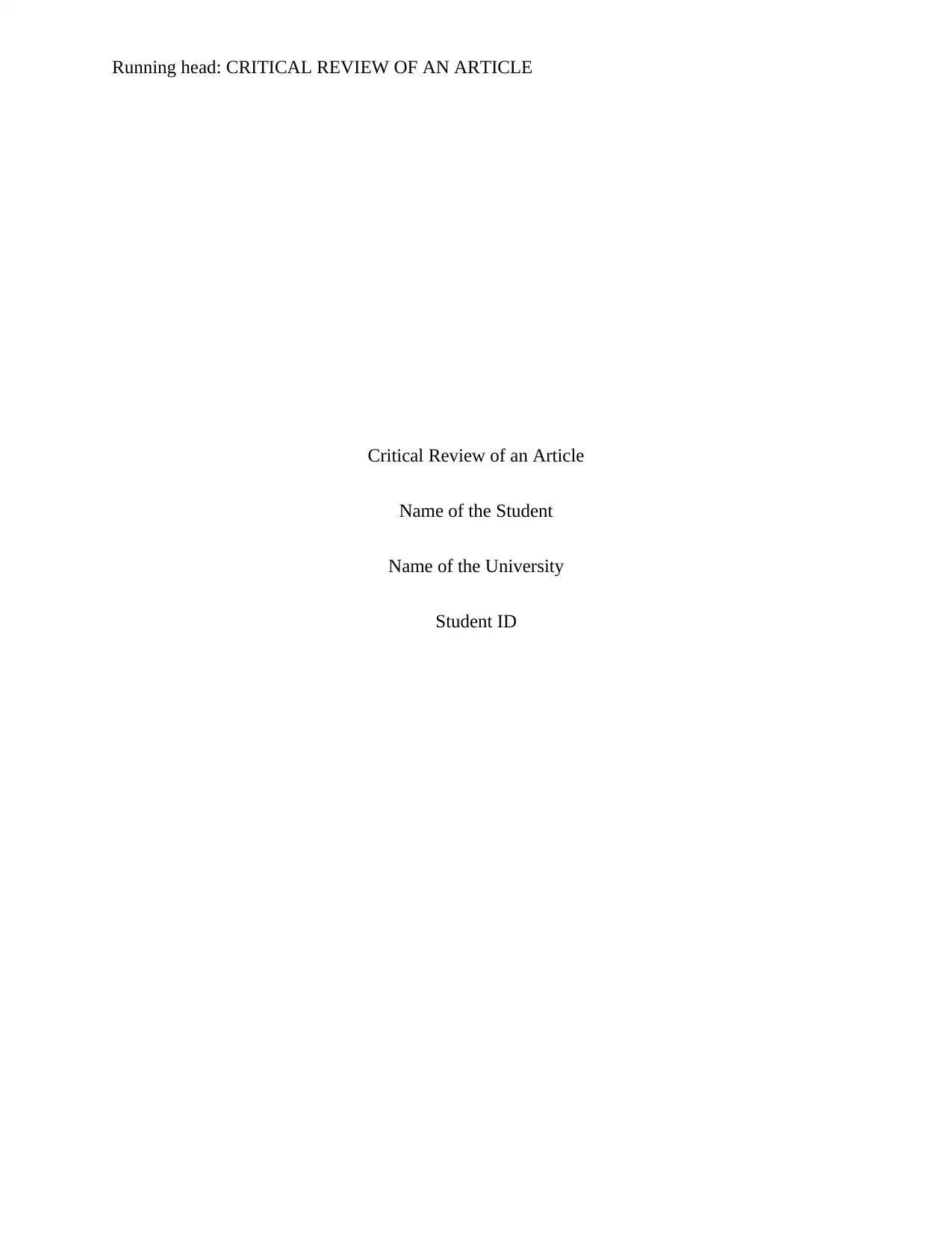
Running head: CRITICAL REVIEW OF AN ARTICLE
Critical Review of an Article
Name of the Student
Name of the University
Student ID
Critical Review of an Article
Name of the Student
Name of the University
Student ID
Paraphrase This Document
Need a fresh take? Get an instant paraphrase of this document with our AI Paraphraser
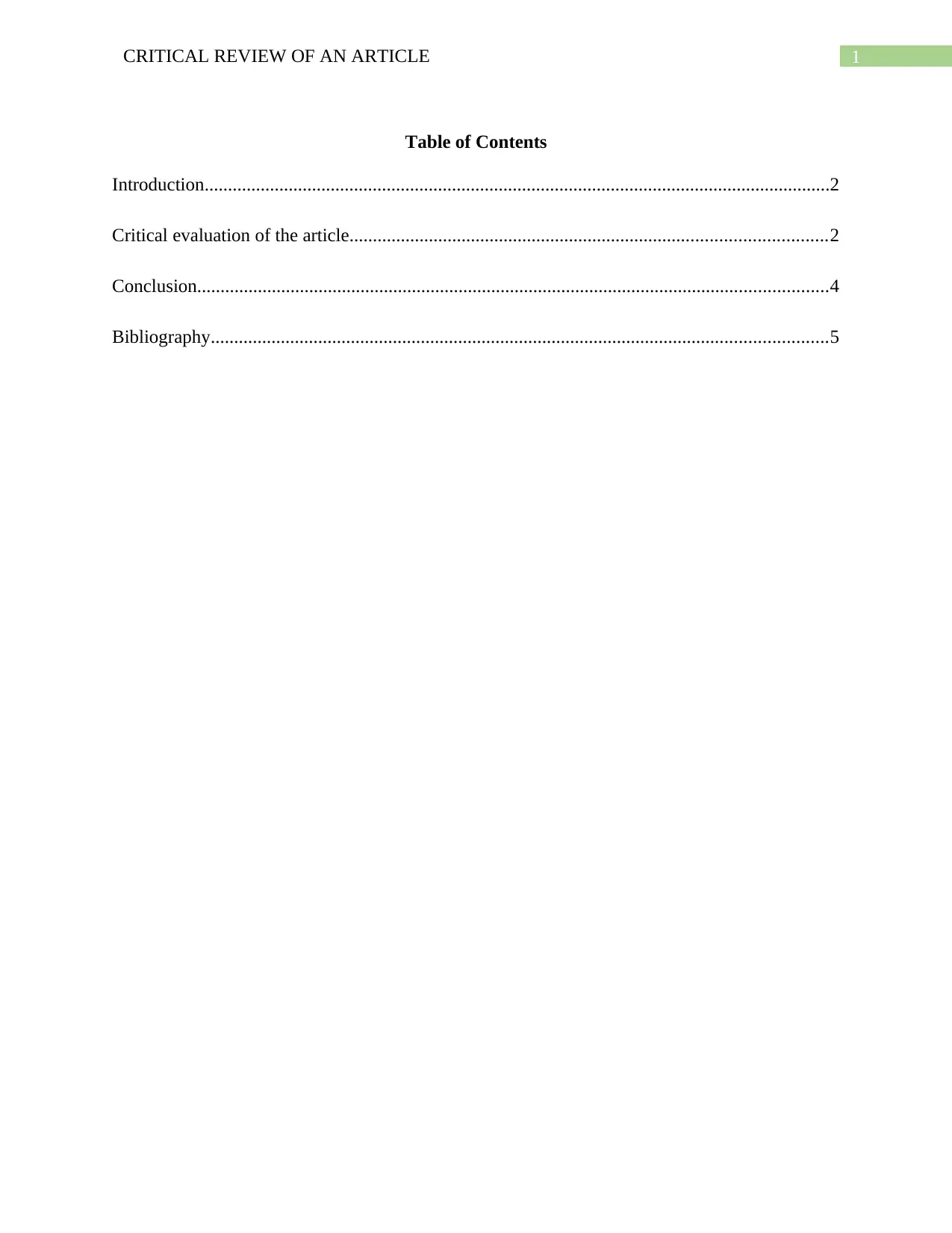
1CRITICAL REVIEW OF AN ARTICLE
Table of Contents
Introduction......................................................................................................................................2
Critical evaluation of the article......................................................................................................2
Conclusion.......................................................................................................................................4
Bibliography....................................................................................................................................5
Table of Contents
Introduction......................................................................................................................................2
Critical evaluation of the article......................................................................................................2
Conclusion.......................................................................................................................................4
Bibliography....................................................................................................................................5
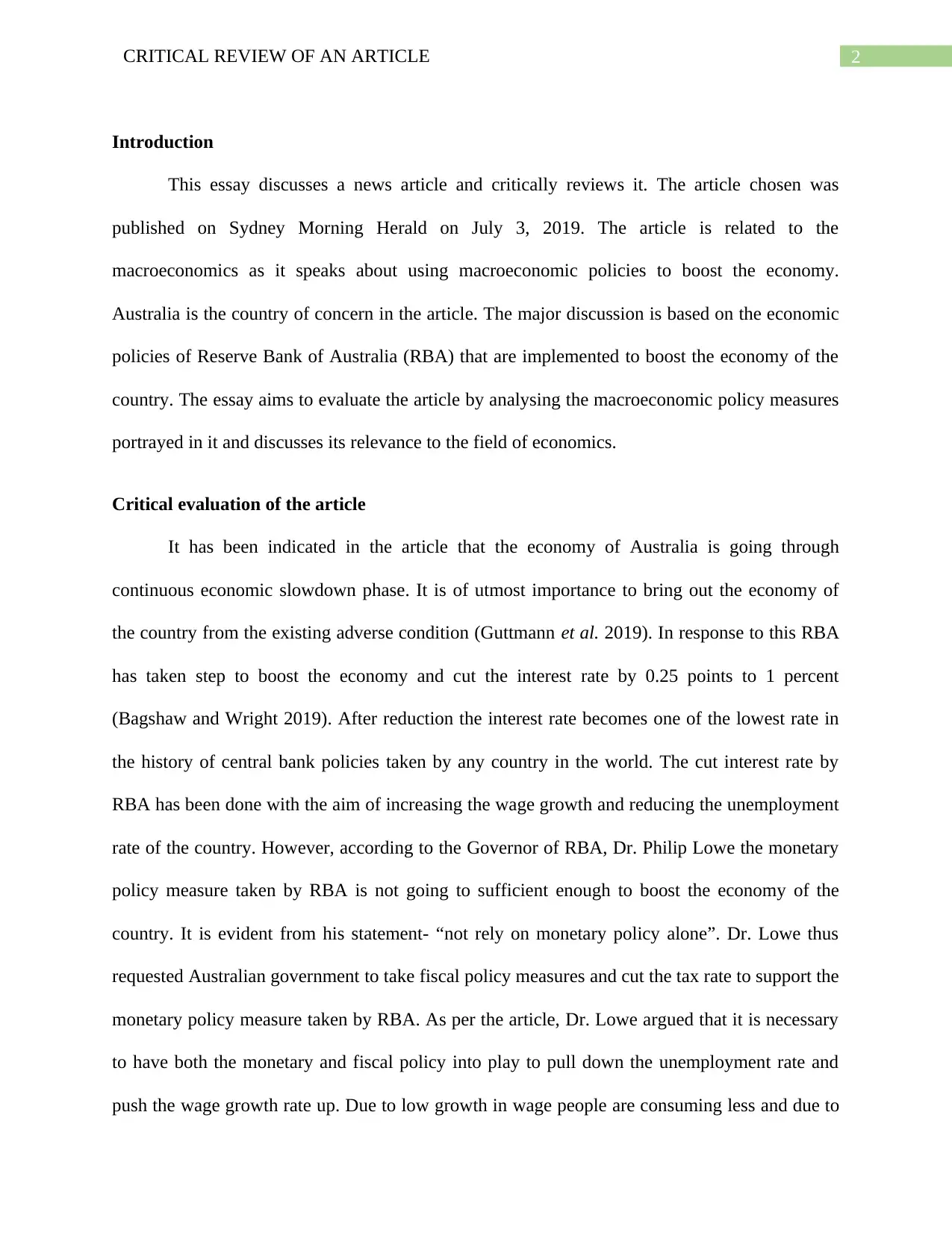
2CRITICAL REVIEW OF AN ARTICLE
Introduction
This essay discusses a news article and critically reviews it. The article chosen was
published on Sydney Morning Herald on July 3, 2019. The article is related to the
macroeconomics as it speaks about using macroeconomic policies to boost the economy.
Australia is the country of concern in the article. The major discussion is based on the economic
policies of Reserve Bank of Australia (RBA) that are implemented to boost the economy of the
country. The essay aims to evaluate the article by analysing the macroeconomic policy measures
portrayed in it and discusses its relevance to the field of economics.
Critical evaluation of the article
It has been indicated in the article that the economy of Australia is going through
continuous economic slowdown phase. It is of utmost importance to bring out the economy of
the country from the existing adverse condition (Guttmann et al. 2019). In response to this RBA
has taken step to boost the economy and cut the interest rate by 0.25 points to 1 percent
(Bagshaw and Wright 2019). After reduction the interest rate becomes one of the lowest rate in
the history of central bank policies taken by any country in the world. The cut interest rate by
RBA has been done with the aim of increasing the wage growth and reducing the unemployment
rate of the country. However, according to the Governor of RBA, Dr. Philip Lowe the monetary
policy measure taken by RBA is not going to sufficient enough to boost the economy of the
country. It is evident from his statement- “not rely on monetary policy alone”. Dr. Lowe thus
requested Australian government to take fiscal policy measures and cut the tax rate to support the
monetary policy measure taken by RBA. As per the article, Dr. Lowe argued that it is necessary
to have both the monetary and fiscal policy into play to pull down the unemployment rate and
push the wage growth rate up. Due to low growth in wage people are consuming less and due to
Introduction
This essay discusses a news article and critically reviews it. The article chosen was
published on Sydney Morning Herald on July 3, 2019. The article is related to the
macroeconomics as it speaks about using macroeconomic policies to boost the economy.
Australia is the country of concern in the article. The major discussion is based on the economic
policies of Reserve Bank of Australia (RBA) that are implemented to boost the economy of the
country. The essay aims to evaluate the article by analysing the macroeconomic policy measures
portrayed in it and discusses its relevance to the field of economics.
Critical evaluation of the article
It has been indicated in the article that the economy of Australia is going through
continuous economic slowdown phase. It is of utmost importance to bring out the economy of
the country from the existing adverse condition (Guttmann et al. 2019). In response to this RBA
has taken step to boost the economy and cut the interest rate by 0.25 points to 1 percent
(Bagshaw and Wright 2019). After reduction the interest rate becomes one of the lowest rate in
the history of central bank policies taken by any country in the world. The cut interest rate by
RBA has been done with the aim of increasing the wage growth and reducing the unemployment
rate of the country. However, according to the Governor of RBA, Dr. Philip Lowe the monetary
policy measure taken by RBA is not going to sufficient enough to boost the economy of the
country. It is evident from his statement- “not rely on monetary policy alone”. Dr. Lowe thus
requested Australian government to take fiscal policy measures and cut the tax rate to support the
monetary policy measure taken by RBA. As per the article, Dr. Lowe argued that it is necessary
to have both the monetary and fiscal policy into play to pull down the unemployment rate and
push the wage growth rate up. Due to low growth in wage people are consuming less and due to
⊘ This is a preview!⊘
Do you want full access?
Subscribe today to unlock all pages.

Trusted by 1+ million students worldwide
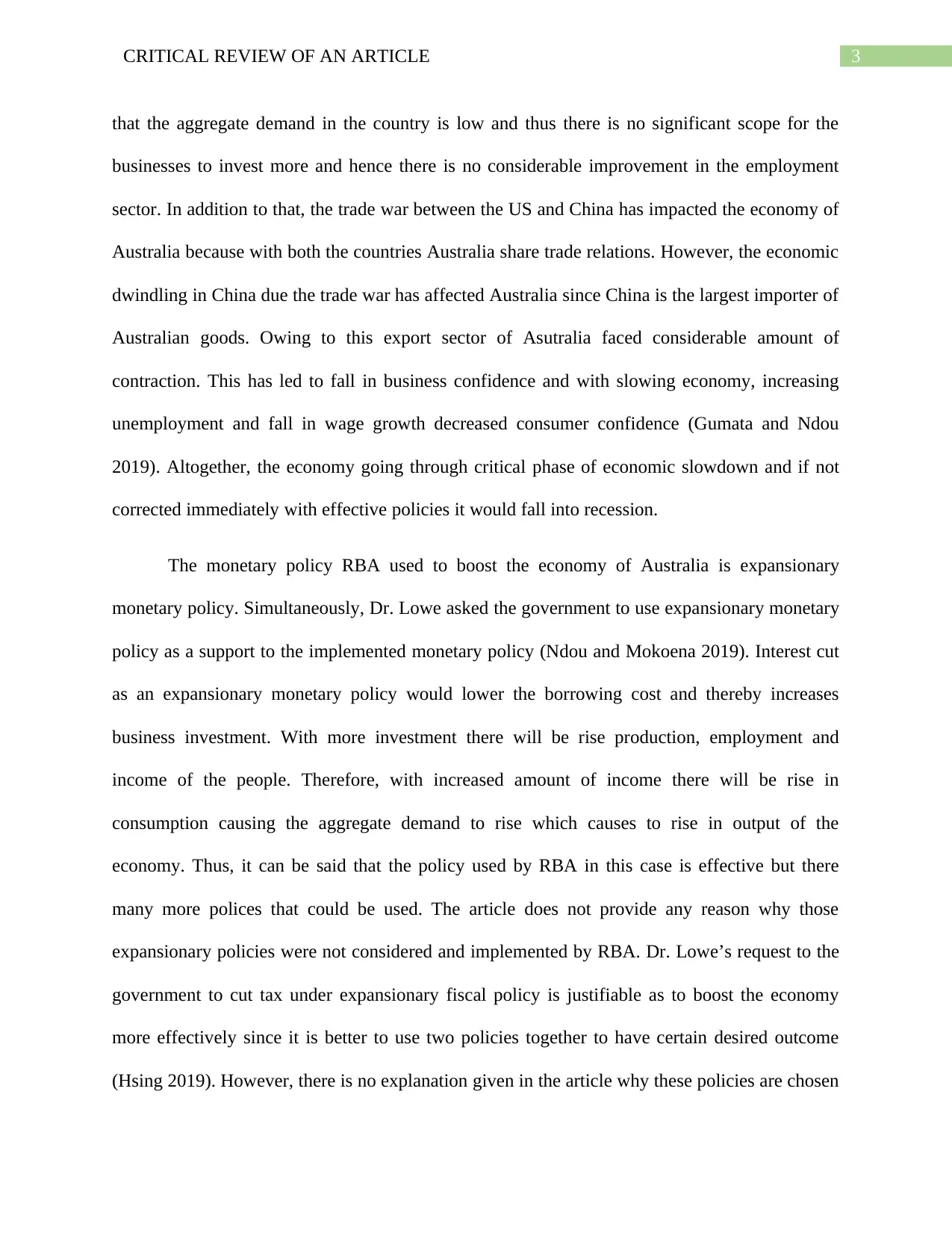
3CRITICAL REVIEW OF AN ARTICLE
that the aggregate demand in the country is low and thus there is no significant scope for the
businesses to invest more and hence there is no considerable improvement in the employment
sector. In addition to that, the trade war between the US and China has impacted the economy of
Australia because with both the countries Australia share trade relations. However, the economic
dwindling in China due the trade war has affected Australia since China is the largest importer of
Australian goods. Owing to this export sector of Asutralia faced considerable amount of
contraction. This has led to fall in business confidence and with slowing economy, increasing
unemployment and fall in wage growth decreased consumer confidence (Gumata and Ndou
2019). Altogether, the economy going through critical phase of economic slowdown and if not
corrected immediately with effective policies it would fall into recession.
The monetary policy RBA used to boost the economy of Australia is expansionary
monetary policy. Simultaneously, Dr. Lowe asked the government to use expansionary monetary
policy as a support to the implemented monetary policy (Ndou and Mokoena 2019). Interest cut
as an expansionary monetary policy would lower the borrowing cost and thereby increases
business investment. With more investment there will be rise production, employment and
income of the people. Therefore, with increased amount of income there will be rise in
consumption causing the aggregate demand to rise which causes to rise in output of the
economy. Thus, it can be said that the policy used by RBA in this case is effective but there
many more polices that could be used. The article does not provide any reason why those
expansionary policies were not considered and implemented by RBA. Dr. Lowe’s request to the
government to cut tax under expansionary fiscal policy is justifiable as to boost the economy
more effectively since it is better to use two policies together to have certain desired outcome
(Hsing 2019). However, there is no explanation given in the article why these policies are chosen
that the aggregate demand in the country is low and thus there is no significant scope for the
businesses to invest more and hence there is no considerable improvement in the employment
sector. In addition to that, the trade war between the US and China has impacted the economy of
Australia because with both the countries Australia share trade relations. However, the economic
dwindling in China due the trade war has affected Australia since China is the largest importer of
Australian goods. Owing to this export sector of Asutralia faced considerable amount of
contraction. This has led to fall in business confidence and with slowing economy, increasing
unemployment and fall in wage growth decreased consumer confidence (Gumata and Ndou
2019). Altogether, the economy going through critical phase of economic slowdown and if not
corrected immediately with effective policies it would fall into recession.
The monetary policy RBA used to boost the economy of Australia is expansionary
monetary policy. Simultaneously, Dr. Lowe asked the government to use expansionary monetary
policy as a support to the implemented monetary policy (Ndou and Mokoena 2019). Interest cut
as an expansionary monetary policy would lower the borrowing cost and thereby increases
business investment. With more investment there will be rise production, employment and
income of the people. Therefore, with increased amount of income there will be rise in
consumption causing the aggregate demand to rise which causes to rise in output of the
economy. Thus, it can be said that the policy used by RBA in this case is effective but there
many more polices that could be used. The article does not provide any reason why those
expansionary policies were not considered and implemented by RBA. Dr. Lowe’s request to the
government to cut tax under expansionary fiscal policy is justifiable as to boost the economy
more effectively since it is better to use two policies together to have certain desired outcome
(Hsing 2019). However, there is no explanation given in the article why these policies are chosen
Paraphrase This Document
Need a fresh take? Get an instant paraphrase of this document with our AI Paraphraser
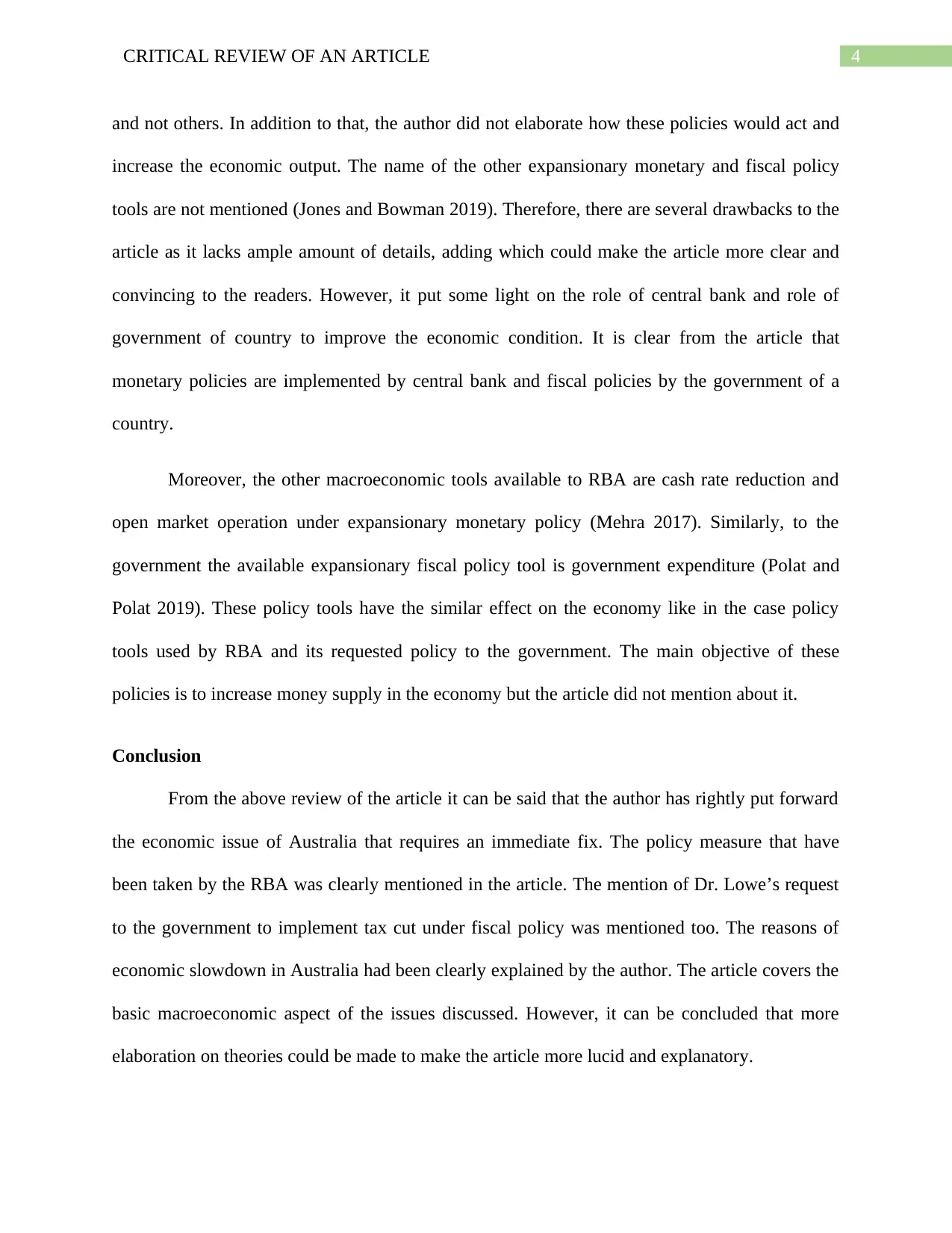
4CRITICAL REVIEW OF AN ARTICLE
and not others. In addition to that, the author did not elaborate how these policies would act and
increase the economic output. The name of the other expansionary monetary and fiscal policy
tools are not mentioned (Jones and Bowman 2019). Therefore, there are several drawbacks to the
article as it lacks ample amount of details, adding which could make the article more clear and
convincing to the readers. However, it put some light on the role of central bank and role of
government of country to improve the economic condition. It is clear from the article that
monetary policies are implemented by central bank and fiscal policies by the government of a
country.
Moreover, the other macroeconomic tools available to RBA are cash rate reduction and
open market operation under expansionary monetary policy (Mehra 2017). Similarly, to the
government the available expansionary fiscal policy tool is government expenditure (Polat and
Polat 2019). These policy tools have the similar effect on the economy like in the case policy
tools used by RBA and its requested policy to the government. The main objective of these
policies is to increase money supply in the economy but the article did not mention about it.
Conclusion
From the above review of the article it can be said that the author has rightly put forward
the economic issue of Australia that requires an immediate fix. The policy measure that have
been taken by the RBA was clearly mentioned in the article. The mention of Dr. Lowe’s request
to the government to implement tax cut under fiscal policy was mentioned too. The reasons of
economic slowdown in Australia had been clearly explained by the author. The article covers the
basic macroeconomic aspect of the issues discussed. However, it can be concluded that more
elaboration on theories could be made to make the article more lucid and explanatory.
and not others. In addition to that, the author did not elaborate how these policies would act and
increase the economic output. The name of the other expansionary monetary and fiscal policy
tools are not mentioned (Jones and Bowman 2019). Therefore, there are several drawbacks to the
article as it lacks ample amount of details, adding which could make the article more clear and
convincing to the readers. However, it put some light on the role of central bank and role of
government of country to improve the economic condition. It is clear from the article that
monetary policies are implemented by central bank and fiscal policies by the government of a
country.
Moreover, the other macroeconomic tools available to RBA are cash rate reduction and
open market operation under expansionary monetary policy (Mehra 2017). Similarly, to the
government the available expansionary fiscal policy tool is government expenditure (Polat and
Polat 2019). These policy tools have the similar effect on the economy like in the case policy
tools used by RBA and its requested policy to the government. The main objective of these
policies is to increase money supply in the economy but the article did not mention about it.
Conclusion
From the above review of the article it can be said that the author has rightly put forward
the economic issue of Australia that requires an immediate fix. The policy measure that have
been taken by the RBA was clearly mentioned in the article. The mention of Dr. Lowe’s request
to the government to implement tax cut under fiscal policy was mentioned too. The reasons of
economic slowdown in Australia had been clearly explained by the author. The article covers the
basic macroeconomic aspect of the issues discussed. However, it can be concluded that more
elaboration on theories could be made to make the article more lucid and explanatory.
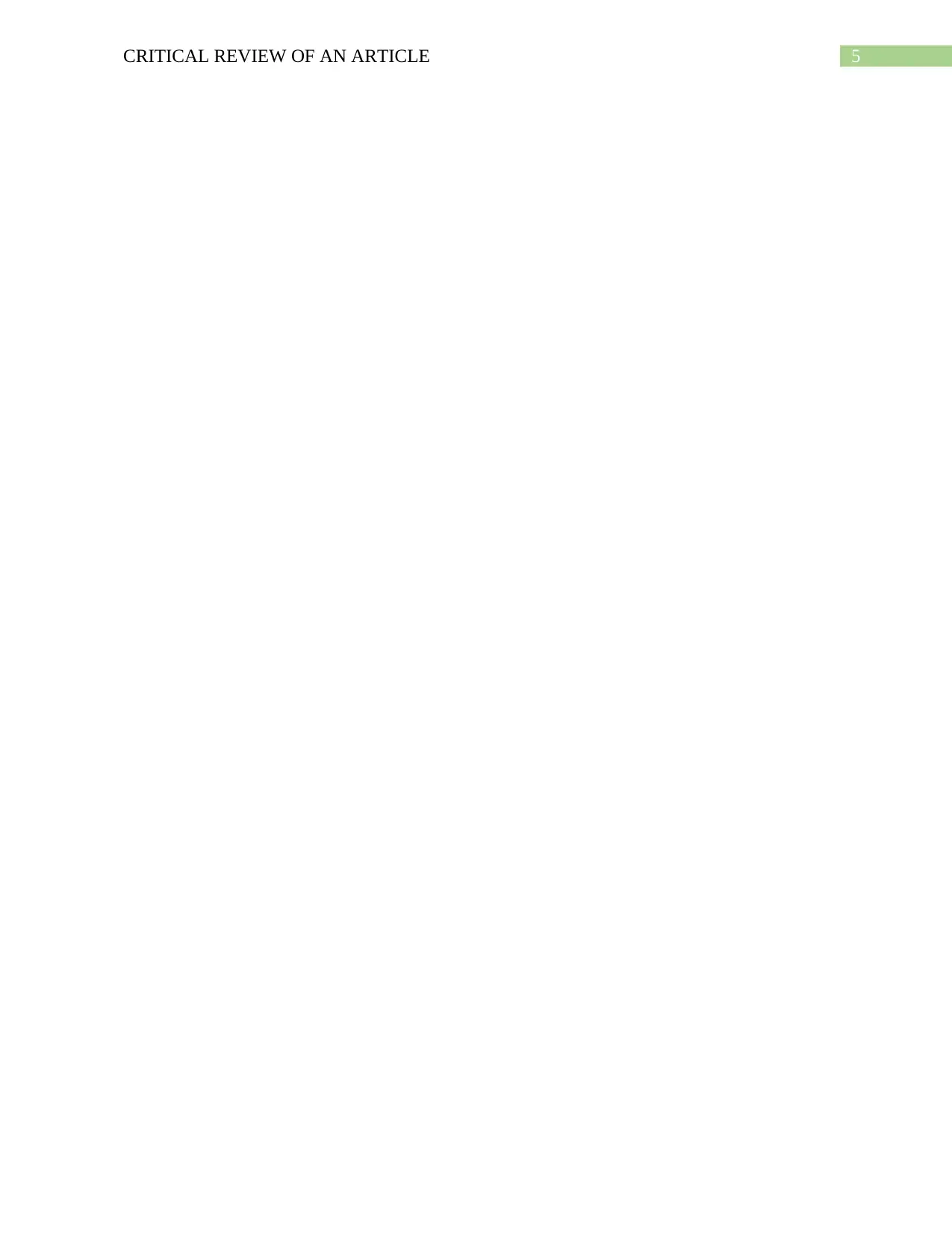
5CRITICAL REVIEW OF AN ARTICLE
⊘ This is a preview!⊘
Do you want full access?
Subscribe today to unlock all pages.

Trusted by 1+ million students worldwide
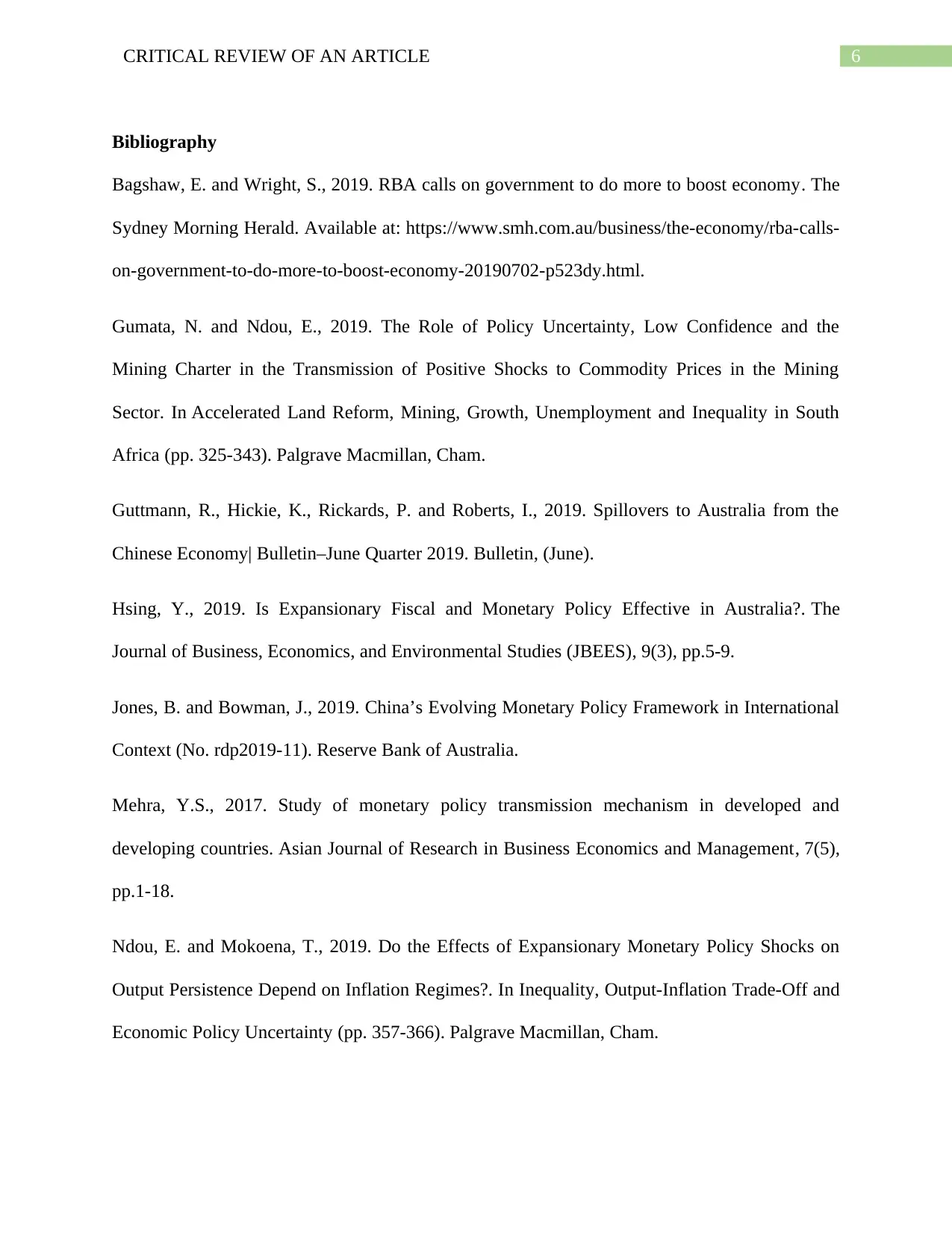
6CRITICAL REVIEW OF AN ARTICLE
Bibliography
Bagshaw, E. and Wright, S., 2019. RBA calls on government to do more to boost economy. The
Sydney Morning Herald. Available at: https://www.smh.com.au/business/the-economy/rba-calls-
on-government-to-do-more-to-boost-economy-20190702-p523dy.html.
Gumata, N. and Ndou, E., 2019. The Role of Policy Uncertainty, Low Confidence and the
Mining Charter in the Transmission of Positive Shocks to Commodity Prices in the Mining
Sector. In Accelerated Land Reform, Mining, Growth, Unemployment and Inequality in South
Africa (pp. 325-343). Palgrave Macmillan, Cham.
Guttmann, R., Hickie, K., Rickards, P. and Roberts, I., 2019. Spillovers to Australia from the
Chinese Economy| Bulletin–June Quarter 2019. Bulletin, (June).
Hsing, Y., 2019. Is Expansionary Fiscal and Monetary Policy Effective in Australia?. The
Journal of Business, Economics, and Environmental Studies (JBEES), 9(3), pp.5-9.
Jones, B. and Bowman, J., 2019. China’s Evolving Monetary Policy Framework in International
Context (No. rdp2019-11). Reserve Bank of Australia.
Mehra, Y.S., 2017. Study of monetary policy transmission mechanism in developed and
developing countries. Asian Journal of Research in Business Economics and Management, 7(5),
pp.1-18.
Ndou, E. and Mokoena, T., 2019. Do the Effects of Expansionary Monetary Policy Shocks on
Output Persistence Depend on Inflation Regimes?. In Inequality, Output-Inflation Trade-Off and
Economic Policy Uncertainty (pp. 357-366). Palgrave Macmillan, Cham.
Bibliography
Bagshaw, E. and Wright, S., 2019. RBA calls on government to do more to boost economy. The
Sydney Morning Herald. Available at: https://www.smh.com.au/business/the-economy/rba-calls-
on-government-to-do-more-to-boost-economy-20190702-p523dy.html.
Gumata, N. and Ndou, E., 2019. The Role of Policy Uncertainty, Low Confidence and the
Mining Charter in the Transmission of Positive Shocks to Commodity Prices in the Mining
Sector. In Accelerated Land Reform, Mining, Growth, Unemployment and Inequality in South
Africa (pp. 325-343). Palgrave Macmillan, Cham.
Guttmann, R., Hickie, K., Rickards, P. and Roberts, I., 2019. Spillovers to Australia from the
Chinese Economy| Bulletin–June Quarter 2019. Bulletin, (June).
Hsing, Y., 2019. Is Expansionary Fiscal and Monetary Policy Effective in Australia?. The
Journal of Business, Economics, and Environmental Studies (JBEES), 9(3), pp.5-9.
Jones, B. and Bowman, J., 2019. China’s Evolving Monetary Policy Framework in International
Context (No. rdp2019-11). Reserve Bank of Australia.
Mehra, Y.S., 2017. Study of monetary policy transmission mechanism in developed and
developing countries. Asian Journal of Research in Business Economics and Management, 7(5),
pp.1-18.
Ndou, E. and Mokoena, T., 2019. Do the Effects of Expansionary Monetary Policy Shocks on
Output Persistence Depend on Inflation Regimes?. In Inequality, Output-Inflation Trade-Off and
Economic Policy Uncertainty (pp. 357-366). Palgrave Macmillan, Cham.
Paraphrase This Document
Need a fresh take? Get an instant paraphrase of this document with our AI Paraphraser
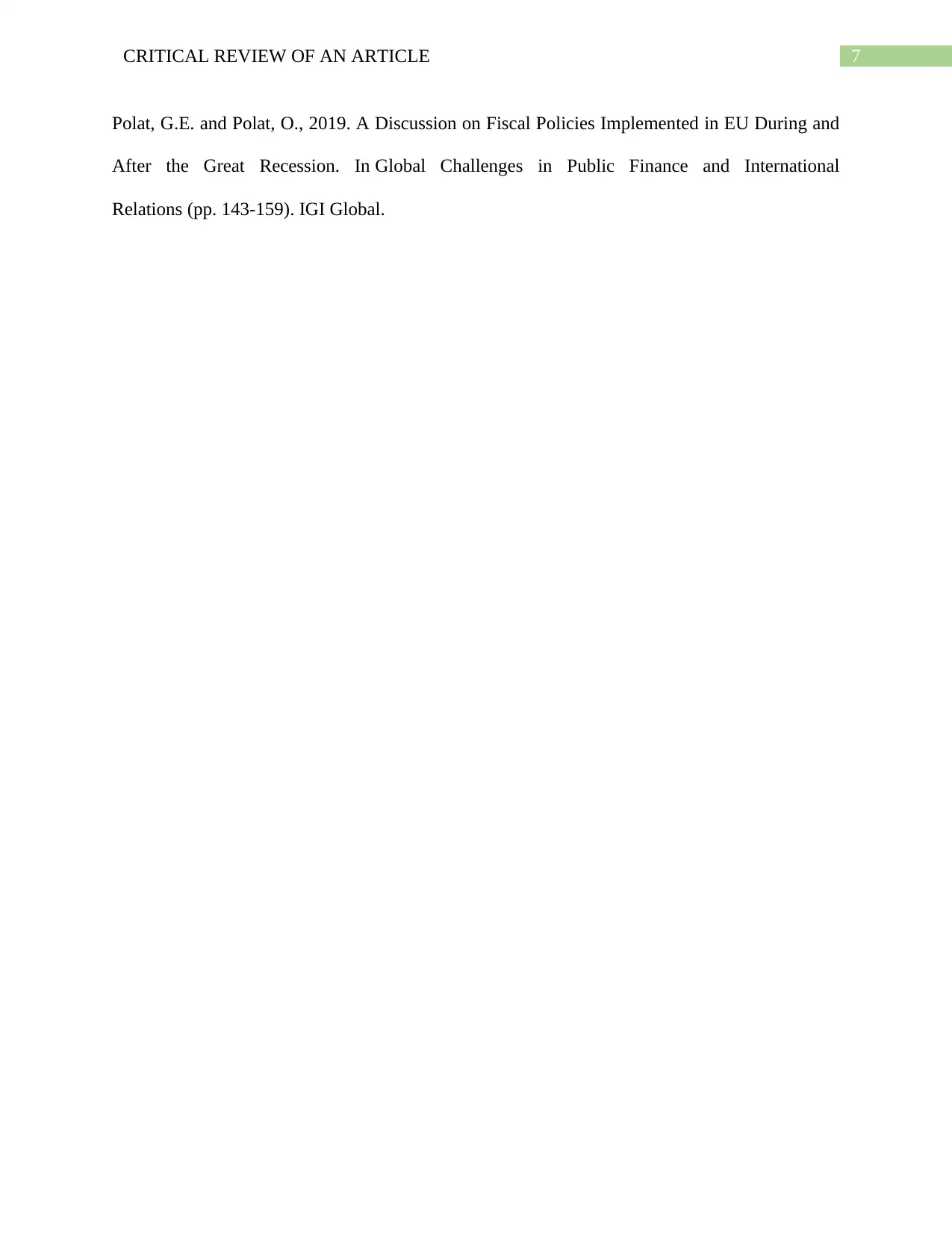
7CRITICAL REVIEW OF AN ARTICLE
Polat, G.E. and Polat, O., 2019. A Discussion on Fiscal Policies Implemented in EU During and
After the Great Recession. In Global Challenges in Public Finance and International
Relations (pp. 143-159). IGI Global.
Polat, G.E. and Polat, O., 2019. A Discussion on Fiscal Policies Implemented in EU During and
After the Great Recession. In Global Challenges in Public Finance and International
Relations (pp. 143-159). IGI Global.
1 out of 8
Related Documents
Your All-in-One AI-Powered Toolkit for Academic Success.
+13062052269
info@desklib.com
Available 24*7 on WhatsApp / Email
![[object Object]](/_next/static/media/star-bottom.7253800d.svg)
Unlock your academic potential
Copyright © 2020–2025 A2Z Services. All Rights Reserved. Developed and managed by ZUCOL.





